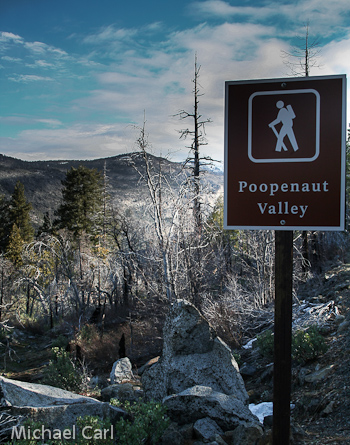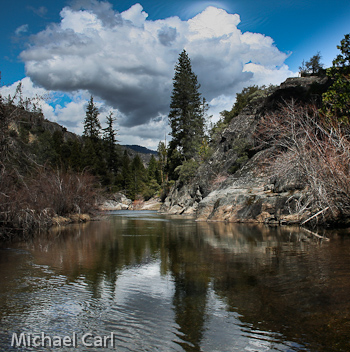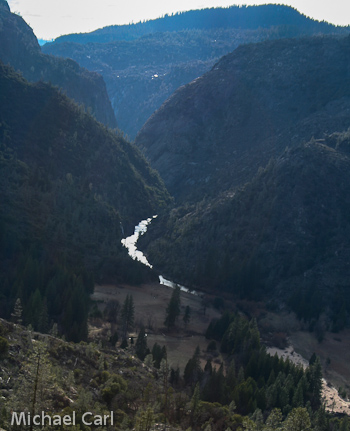Directions
From Manteca
Manteca is located off of Highway 99 - between Stockon to the North and Modesto to the South. From Manteca take Highway 120 for about 70 miles until you reach Evergreen Road. Turn left onto Evergreen Road and drive until you reach Mather Camp inside Yosemite National Park. Proceed pass the gate until you reach the Poopenaut Valley Trail sign. Very limited day use parking is available just off the road next to the tail, and overnight parking is not permitted.
Poopenaut Valley of the Tuolumne River
Downstream of O'Shaughnessy Dam and Hetch Hetchy, the Tuolumne River enters Poopenaut Valley. In Poopenaut Valley, the river meanders below large rock out-croppings into a meadow area where and long-runs are the dominant habitat type.

Important Disclaimer - getting down there is fairly easy. Hiking back out is a bitch. The trail down to the river drops about 1200 feet within a mile. In all my hiking throughout the Sierras, this single stretch remains one of the toughest humps I can remember. Seriously consider the phyiscal effort before you set out on fishing the Poopenaut, or as it's infamously known - The Pooping Out Valley.

Meadows make up most of the valley floor and consist of wet and dry meadow areas (Figure 6-41). Wet meadows have a higher abundance of sedges and wetland grasses while dry meadows have more mesic grass species associated with them. Wet meadows are inundated for a portion of the year and exhibit wetland characteristics; dry meadows are typically inundated for short periods. Dry meadow grasses included some forage grasses indicating some historic grazing effects.
The Poopenaut Valley has long runs, but you'll also find areas of dense willows along this reach. On the valley floor, black cottonwood is common, which is unusual because it was rarely observed on other stream reaches of the Tuolumne. Most of the black cottonwood population grows in areas away from the main channel along small tributaries. Black cottonwood is not found in the dense thickets of willows lining the channel at the downstream end of the valley. Red willow and shiny willow are equally abundant. Ponderosa pine, white fir, cottonwood, white alder, red willow and shiny willow grow throughout the upper end of Poopenaut Valley.
Fish Species
Trout found in the Poopenaut Valley include brown and rainbow trout. Prior to fish stocking, the Hetch Hetchy Reach may have been the upstream limit of native rainbow trout in the Tuolumne River. According to Dr. Peter Moyle, native trout apparently did not reach Hetch Hetchy Valley. Rainbow trout and brown trout are the only species recorded upstream of Preston Falls on the Tuolumne River. Preston Falls is a natural barrier to upstream distribution of native freshwater fish. Brown trout (non-native) predominate in the uppermost portions of Poopenaut Valley but become proportionally less abundant in the downstream direction. Rainbow trout predominate in the lowermost reach, downstream of Preston Falls.

The USFWS surveys estimate the tailwater below Hetch Hetchy supports approximately 6,000 to 9,000 trout. Brown trout largely dominate the big pools of the upper reach. The predominance of brown trout in the upstream portions of the reach may be driven by lower water temperatures (e.g., Moyle and Marchetti 1992) or the prevalence of deep pool habitat in the upstream subreaches. Where rainbow and brown trout co-occur, they may compete for food and space but can coexist by occupying different locations and using different feeding strategies. Brown trout are usually found in pools feeding on bottom invertebrates and other fish, while rainbow trout are most likely to reside in riffles feeding on surface insects and drift (Moyle 2002). Riffles are uncommon in the Hetchy Reach, comprising only 2.3% of the total reach length.
The USFWS (1976) sampled benthic macroinvertebrates at five riffle locations from late spring through early fall in 1968, 1969, 1970, They concluded that benthic macroinvertebrate production in the reach was very low, possibly due to the "infertility of the water" and "sizeable and sudden changes in flow volume" (USFWS 1976). Analysis of trout gut contents made in conjunction with the invertebrate surveys noted the importance of terrestrial insects in the trout diet. Stomach content analysis of 34 brown and rainbow trout collected May 1970 identified ants, bees,and beetles (Hymenoptera and Coleoptera) as the main component of the trout diet.

